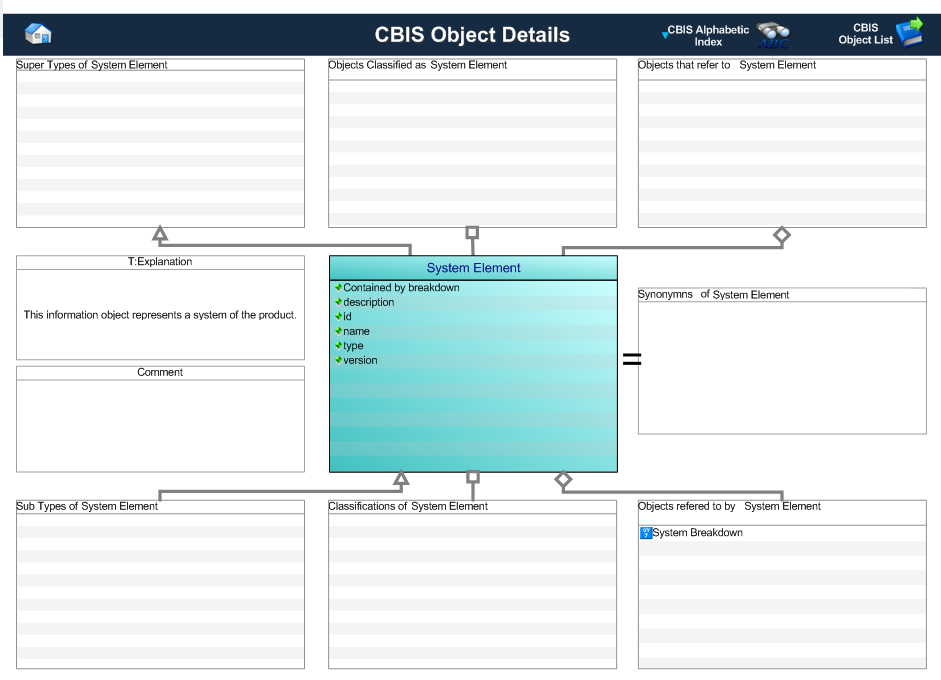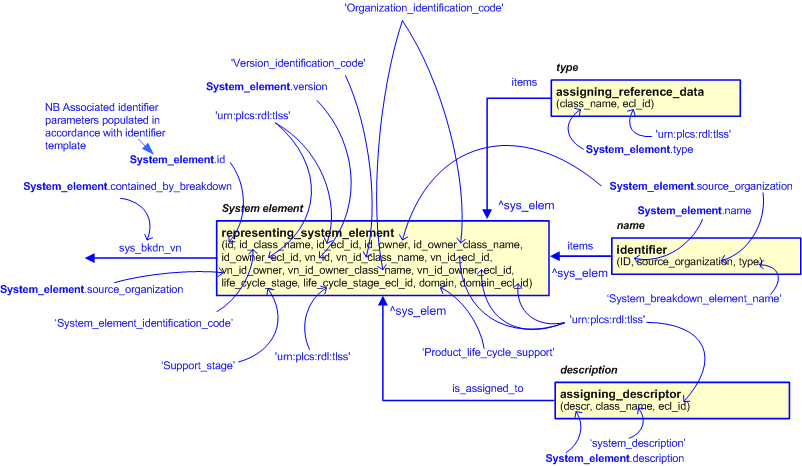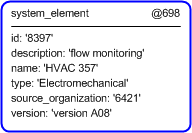Template:— system_element (sys_elt)
Context:— UK_Defence |
Date: 2009/04/17 12:14:10
Revision: 1.2
|
This section specifies the template system_element.
NOTE
The template has been defined in the context of
UK_Defence.
Refer to the business context for details of related templates.
NOTE
An explanation of a template and the associated instantiation path is
provided in the
Template overview
section.
This template describes how to represent the UK_Defence concept of a system breakdown element
in terms of PLCS model elements (templates, entities, and reference data).
This information object represents a system of the product.
This information object represents a system of the product.
Figure 1 — Graphical Representation for Business Object System Element
|
Attribute name
|
Attribute description
|
Attribute type
|
Optionality
|
| id |
This attribute provides the identification of the system breakdown element. |
Identifier |
Mandatory |
| Identifier.id |
This is the value of the id attribute of the Identifier applied to the System Element. |
intrinsic |
Mandatory |
| Identifier.type |
This attribute is the type associated with the id of the Identifier given to the System Element. This must be one of the classes
provided.
|
System_element_identification_code |
Mandatory |
| Identifier.source_organization |
This attribute is the value representing the source organization that provides the id of the Identifier given to the System
Element. This value is assumed to be a type of Organization_identification_code.
|
Organization_identification_code |
Mandatory |
| description |
This attribute provides the description of the Item. |
Intrinsic |
Mandatory |
| name |
This attribute provides the name of the system element. |
Intrinsic |
Mandatory |
| type |
This optional attribute indicates the type of system items covered by the breakdown. |
Intrinsic |
Mandatory |
| version |
This attribute provides the version of the system element. |
Intrinsic |
Mandatory |
| contained_by_breakdown |
This is the reference to the breakdown within which, this item is contained. |
System element breakdown |
Mandatory |
Table 1 — System Element attribute details
The EXPRESS-G diagram in
Figure
2
shows the templates and EXPRESS entities that are required
to represent the template
"system_element".
The text highlighted in blue shows the template parameters.
Figure 2 — An EXPRESS-G representation of the Information model for system_element
The graphic for the template to be used in other EXPRESS-G diagrams
is shown in Figure
3
below.
Figure 3 — The graphical representation of the system_element template
The following input parameters are defined for this template:
The identifier of the system element.
The description of the system element.
The name of the system element.
type (Default=System_element_type,Type='CLASS')
The type of the physical breakdown item.
The identifier of the organization that owns the id. It is assumed that this will be of type Organization_identification_code
and not an Organization name.
The breakdown version that contains this element.
The identifier of the functional breakdown version.
The following reference parameters are defined for this template:
Allow the
System_element
entity instantiated in this path to be referenced when this template is used.
Note: The
System_element
entity can be referenced in a template path by:
%^target = $system_element.sys_elem%
Allow the
System_element_version
entity instantiated in this path to be referenced when this template is used.
%^target = $system_element.sys_elem_vn%
%^target = $system_element.sys_elem_def%
%^target = $system_element.def_cntxt%
%^target = $system_element.sys_cntxt%
The instantiation path shown below specifies the entities that are to be
instantiated by the template.
A description of templates and the syntax for the instantiation path is
provided in the
Templates Help/Information section.
/
representing_system_element(
id=@id,
id_class_name='System_element_identification_code',
id_ecl_id='urn:plcs:rdl:uk_defence',
id_owner=@source_organization,
id_owner_class_name='Organization_identification_code',
id_owner_ecl_id='urn:plcs:rdl:uk_defence',
vn_id=@version,
vn_id_class_name='Version_identification_code',
vn_id_ecl_id='urn:plcs:rdl:uk_defence',
vn_id_owner=@source_organization,
vn_id_owner_class_name='Organization_identification_code',
vn_id_owner_ecl_id='urn:plcs:rdl:uk_defence',
life_cycle_stage='Support_stage',
life_cycle_stage_ecl_id='urn:plcs:rdl:uk_defence',
domain='Product_life_cycle_support',
domain_ecl_id='urn:plcs:rdl:uk_defence')/
-- assign ref parameters %^sys_elem = $representing_system_element.sys_elem%
%^sys_elem_vn = $representing_system_element.sys_elem_vn%
%^sys_elem_def = $representing_system_element.sys_elem_def%
%^def_cntxt = $representing_system_element.def_cntxt%
%^sys_cntxt = $representing_system_element.sys_cntxt%
^sys_cntxt.breakdown ->
@contained_by_breakdown-- name /
identifier(
ID=@name,
source_organization=@source_organization,
type='System_breakdown_element_name',
items=^sys_elem)/
-- type /
assigning_reference_data(
items=^sys_elem,
class_name=@type,
ecl_id='urn:plcs:rdl:uk_defence')/
-- description /
assigning_descriptor(
descr=@description,
class_name='system_description',
ecl_id='urn:plcs:rdl:uk_defence',
is_assigned_to=^sys_elem)/
The instance diagram in Figure
4
shows an example of the EXPRESS entities and templates that are instantiated by the template:
/system_element(id='8397', description='flow monitoring', name='HVAC 357', type='Electromechanical', version='version A08', source_organization='6421')/
(an illustration of the consolidated system_element template is shown in
Figure
5 below.)
Figure 4 — Entities instantiated by system_element template
The instance diagram in
Figure
5
shows the graphic symbol for the template that is to be
used in other instance diagrams. The example template is:
/system_element(id='8397', description='flow monitoring', name='HVAC 357', type='Electromechanical', version='version A08', source_organization='6421')/
Figure 5 — Instantiation of system_element template
Characterizations
No common characterizations of the template
system_element
have been identified. However, the ISO 10303-239 EXPRESS model
may enable other assignments to the entities instantiated by the template.




